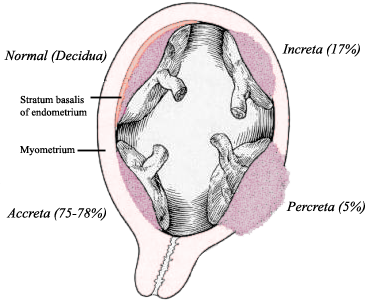Copy link
Placenta accreta: Risk factors
Last updated: 03/06/2015
Placenta accreta occurs when all or part of the placenta attaches abnormally to the to the myometrium, rather than being restricted within the decidua basalis. Placenta accreta is different from Placenta increta (invading into the myometrium) and placenta percreta (extending through the myometrium and attaching to surrounding structures).
Risk factors: An important risk factor for placenta accreta is placenta previa in the presence of a uterine scar. Thus, a history of 1 or more previous cesarean sections is particuarly important. Additional reported risk factors for placenta accreta include maternal age and multiparity, other prior uterine surgery, prior uterine curettage, uterine irradiation,endometrial ablation, Asherman syndrome, uterine leiomyomata, uterine anomalies, hypertensive disorders of pregnancy, and smoking.

References
- Publications Committee, Society for Maternal-Fetal Medicine, Michael A Belfort Placenta accreta. Am. J. Obstet. Gynecol.: 2010, 203(5);430-9 PubMed Link
Other References
- Keys to the Cart: March 1, 2019 Placenta accreta Link
Copyright Information

This work is licensed under a Creative Commons Attribution-NonCommercial-NoDerivatives 4.0 International License.